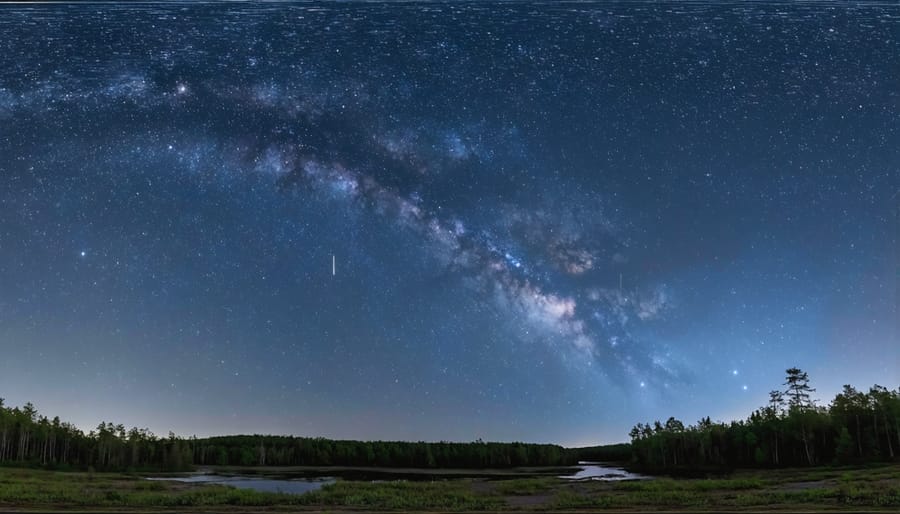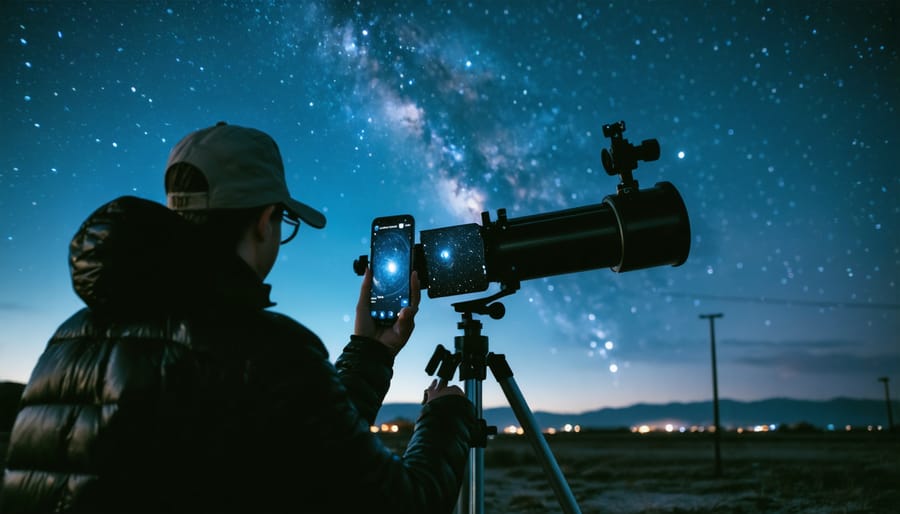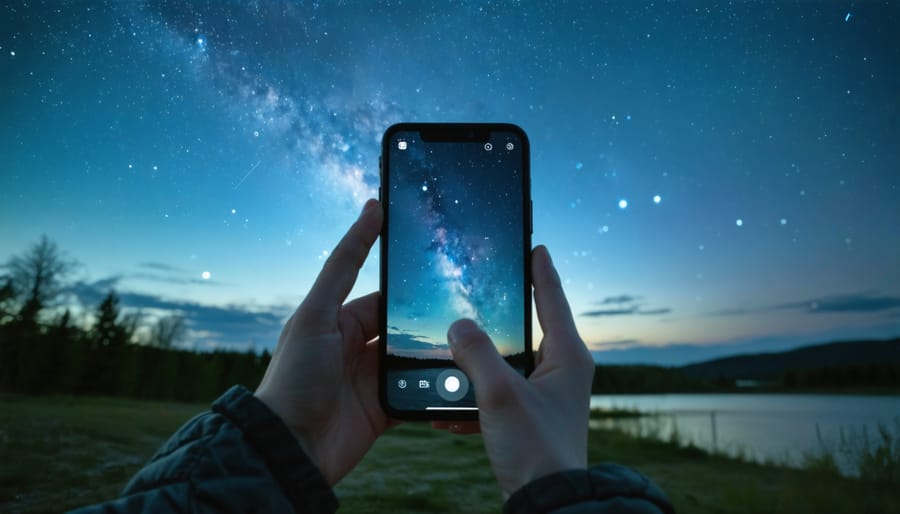Unlock the mysteries of the cosmos with today’s sophisticated interactive night sky maps – digital windows to the stars that transform your smartphone or tablet into a personal planetarium. These powerful tools merge GPS technology with real-time astronomical data, allowing you to identify constellations, track planets, and discover deep-space objects simply by pointing your device skyward. Whether you’re a seasoned stargazer or taking your first steps into amateur astronomy, interactive sky maps offer an accessible gateway to understanding our universe, combining ancient celestial knowledge with modern technological precision.
For Ontario stargazers, these digital guides prove particularly valuable during the clear winter nights and warm summer evenings when the province’s dark-sky preserves reveal their full stellar splendor. From tracking the Northern Lights in Manitoulin Island to identifying the summer triangle high above Algonquin Park, interactive sky maps help transform casual observation into meaningful astronomical exploration. With features like augmented reality overlays, night-vision modes, and customizable viewing options, these digital companions make the vast expanse above more accessible and engaging than ever before.
Getting Started with Your Digital Star Map
Choosing the Right Star Map App
When it comes to exploring Ontario’s starlit skies, having the right star map app can make all the difference. For beginners, we recommend Stellarium Mobile, which offers an intuitive interface and excellent star visibility even in light-polluted areas. Its augmented reality feature lets you point your phone at the sky to identify celestial objects instantly.
For more serious stargazers, SkySafari is worth the investment. It includes detailed information about celestial objects and works offline – perfect for remote Ontario parks where cellular service might be spotty. The app’s time-travel feature also helps you plan your viewing sessions around specific astronomical events.
Star Walk 2 is another fantastic option, especially popular among families. Its beautiful graphics and educational content make stargazing both fun and informative. The app includes a special red-light mode to protect your night vision while checking your phone outdoors.
Pro tip: Before heading out, download your chosen app’s offline maps. This ensures you’ll have access to star information even in Ontario’s more remote dark sky viewing locations. Most apps offer free versions with basic features, so you can try them out before committing to a paid version.

Essential Features for Night Navigation
When exploring the night sky, having the right navigation features at your fingertips can transform your stargazing experience into amazing outdoor navigation adventures. Look for a night sky map that includes a compass alignment tool, which helps you match what you see on your screen with the actual sky above. Red light mode is essential to preserve your night vision while checking your device – trust me, your eyes will thank you!
The best apps offer real-time tracking that automatically updates as you move your device across the sky. Make sure your chosen map includes constellation lines and names, making it easier to identify star patterns. A search function is invaluable when you’re trying to locate specific celestial objects, especially during special events like meteor showers or planet alignments.
Another must-have feature is offline functionality – many of Ontario’s best stargazing spots have limited cell coverage. Having detailed information about celestial objects right at your fingertips, even without internet access, ensures you won’t miss out on any astronomical wonders during your nighttime explorations.
Best Stargazing Spots in Ontario Parks
Dark Sky Preserves
Ontario boasts several incredible Dark Sky Preserves, where light pollution is minimal and the stars shine their brightest. These designated areas offer pristine conditions for stargazing enthusiasts and casual observers alike. Torrance Barrens, near Muskoka, holds the distinction of being Canada’s first Dark Sky Preserve, featuring vast open spaces perfect for setting up telescopes and practicing leave no trace principles.
Point Pelee National Park offers exceptional dark sky viewing along its beaches, where the Milky Way reflects brilliantly over Lake Erie’s waters. During summer months, the park hosts special night sky viewing events with local astronomers sharing their knowledge and equipment.
Gordon’s Park on Manitoulin Island is another stellar location, featuring dedicated stargazing platforms and regular astronomy events. The park’s Dark Sky Preserve certification ensures optimal viewing conditions year-round, with special attention paid to controlling artificial light.
For those near Ottawa, the North Frontenac Dark Sky Preserve provides excellent opportunities for astrophotography and meteor shower watching. The preserve maintains several observation pads and offers camping options for overnight stargazing adventures.
Pro tip: Visit during a new moon for the darkest skies, and bring red-light flashlights to preserve your night vision while navigating these spaces. Many preserves offer guided programs and astronomy workshops, making them perfect for both beginners and experienced stargazers.

Seasonal Viewing Points
Ontario’s night sky offers different celestial treats throughout the year, and knowing where to look during each season can enhance your stargazing experience. In winter, head to Algonquin Park’s West Gate, where the crisp, clear nights provide exceptional views of Orion and the Winter Hexagon. The park’s elevated viewing platforms are especially magical when surrounded by snow-covered pines.
Spring brings optimal viewing conditions at Point Pelee National Park, where you can catch glimpses of Leo and Virgo constellations rising above Lake Erie. The park’s southernmost tip offers unobstructed views with minimal light pollution, perfect for watching spring meteor showers.
Summer stargazers should visit the Torrance Barrens Dark-Sky Preserve near Muskoka. This location offers prime viewing of the Milky Way core and summer constellations like Scorpius and Sagittarius. The bare rock landscape provides natural viewing platforms and 360-degree views of the night sky.
For fall viewing, Bruce Peninsula National Park becomes a stargazer’s paradise. The Indian Head Cove area offers dramatic shoreline views paired with excellent visibility of autumn constellations like Pegasus and Andromeda. Pro tip: visit during the new moon phase for the darkest skies and best viewing conditions.
Remember that each location has specific optimal viewing times based on moon phases and weather conditions, so check your interactive sky map before heading out.
Planning Your Night Sky Adventure
Safety First: Night Navigation Tips
While stargazing adventures can be magical, it’s crucial to prioritize your safety when exploring the night sky. Before heading out, make sure you’re equipped with essential wilderness safety skills and the right gear.
Always tell someone about your planned location and expected return time. Pack a reliable flashlight with extra batteries, and consider bringing a red-light headlamp to preserve your night vision while navigating. Keep your phone fully charged and download offline maps of your chosen area – you might not have cell service in remote locations.
Dress appropriately for the weather, remembering that temperatures can drop significantly after sunset. Layer your clothing and pack extra warm gear, even in summer months. A thermos of hot beverages can help keep you comfortable during longer viewing sessions.
Stay aware of your surroundings and stick to marked trails and designated viewing areas. It’s best to scout your location during daylight hours to familiarize yourself with the terrain and potential hazards. Consider joining a local astronomy group for your first few outings – there’s safety (and fun!) in numbers.
Remember to bring basic first aid supplies and emergency gear. A whistle, compass, and backup battery pack for your devices are must-haves. If you’re planning to use your interactive sky map app, ensure it’s fully loaded and tested before heading out. The beauty of the night sky will be much more enjoyable when you know you’re well-prepared for a safe adventure.
What to Pack for Digital Stargazing
Before heading out for your digital stargazing adventure, you’ll want to pack more than just your smartphone or tablet. Along with your essential outdoor equipment, here’s what you need for a comfortable and successful night under the stars.
First, protect your devices. Pack a sturdy case and screen protector for your phone or tablet, and don’t forget a portable power bank with cables – digital star maps can drain your battery quickly. A red light filter or screen overlay helps preserve your night vision while using your device.
Comfort is key when you’re stargazing. Bring a reclining chair or camping mat to avoid neck strain. A cozy blanket and thermos of hot drinks will keep you warm during those cool Ontario nights. Pack some lightweight snacks that won’t crumble in your backpack.
For optimal viewing conditions, include these practical items:
– Microfiber cloth to keep your device screen clean
– Fingerless gloves for easy screen operation in cool weather
– Small towel or tarp to protect your gear from dew
– Insect repellent (especially important during summer months)
– Basic first aid kit
– Headlamp with red light mode
Pro tip: Download your star maps and astronomical data before heading out, as many dark sky locations have limited cell service. Consider bringing a backup paper star chart – sometimes old school methods are the perfect complement to digital tools!
Remember to pack everything in a water-resistant backpack and keep your electronics in sealed plastic bags if there’s any chance of rain or heavy dew.

Making the Most of Your Interactive Map
Tracking Celestial Events
One of the most exciting features of interactive sky maps is their ability to track celestial events in real-time. Whether you’re hoping to catch a meteor shower over Algonquin Park or witness a lunar eclipse from the shores of Lake Superior, these digital tools can help you plan the perfect stargazing experience.
Most interactive maps allow you to fast-forward through time, showing you exactly when and where specific astronomical events will occur. You can track the paths of planets, monitor satellite passes, and even set alerts for upcoming phenomena. For meteor showers, the maps can show you the radiant point – where the meteors appear to originate from in the sky.
Want to photograph the Northern Lights? These maps often include aurora forecasts and visibility predictions, helping you choose the perfect time and location for viewing. They can also show you the moon phases and positions, which is essential for planning nighttime photography sessions.
Pro tip: Look for maps that offer offline functionality, as many of Ontario’s best stargazing spots have limited cell service. Remember to check the weather forecast alongside your celestial tracking to ensure clear viewing conditions.
Photography Integration Tips
Want to capture the magic of Ontario’s night sky? Combining your interactive star map with photography can create stunning results. Start by using your map to identify prime photo opportunities – whether it’s tracking the Milky Way or finding the perfect spot to capture the Northern Lights.
For the best shots, use your interactive map to plan ahead. Most digital star maps can show you exactly where celestial objects will appear and at what time, helping you frame your shots perfectly. Position your camera facing north for star trails, or align it with specific constellations using your map as a guide.
Pro tip: Screenshot your map’s view of expected star positions, then use it as a reference while setting up your camera in the field. This helps ensure you’re pointing your lens in exactly the right direction, even when it’s too dark to see your surroundings clearly.
Remember to adjust your camera settings based on what you’re shooting. For star trails, plan longer exposures of 30 minutes or more. For crisp star points, stick to the “500 rule” – divide 500 by your lens focal length to determine your maximum exposure time in seconds.
Interactive night sky maps have revolutionized the way we explore and understand the cosmos above Ontario’s beautiful dark skies. These digital companions make stargazing more accessible and enjoyable for everyone, from curious beginners to seasoned astronomers. By combining the wonders of technology with the timeless beauty of the night sky, these tools help create unforgettable experiences under the stars.
Whether you’re planning a weekend camping trip to spot constellations or hoping to catch the next meteor shower, interactive sky maps are your perfect guide to the celestial wonders above. They transform what might seem like a confusing array of stars into a fascinating story written across the night sky.
So grab your device, bundle up, and head out to your favorite dark sky viewing spot. Ontario’s pristine night skies are waiting to be discovered, and with an interactive sky map as your guide, you’re all set for an amazing astronomical adventure. Happy stargazing!














+ There are no comments
Add yours